Rescued Rhino Returns to the Wild
Black rhino calf Loijipu returns to Sera Conservancy
A rescued black rhino calf that has spent the last year and a half being hand raised by Samburu keepers at Reteti Elephant Sanctuary was released back into Sera Community Conservancy on the 6th June in a joint operation between the Kenya Wildlife Service and the Northern Rangelands Trust.
Fondly known as ‘Loijipu’, the black rhino calf is the first to be born in a community conservancy in Kenya, but was abandoned by his mother in February 2017. Sera Rhino Sanctuary, in Sera Conservancy, made headlines in 2015 when it became the first community-run black rhino sanctuary in East Africa. Lojipu’s return brings the population to 13.
“We rescued Loijupu after he was abandoned by the mother 48 hours after birth,” says Kenya Wildlife Service vet Dr. Mathew Mutinda. “With close monitoring and care at the Reteti Elephant Sanctuary in Namunyak Community Conservancy, he has done well. Now, at one year four months, his wild instincts are starting to kick in. This is a key indicator that the time has come to re-wild the rhino.”
Reteti keepers bid farewell to Loijipu
Preparations began in earnest in May, which included a site survey, weather predictions and the purchase of new translocation and adaptation kit. On 6th June, a team of dedicated keepers from Reteti Elephant Sanctuary, lead by Dr. Mathew Mutinda, loaded Loijipu into a Landcruiser using a specialised crate.
It took seven hours before Loijipu ventured into his crate (on the right)
“We were hoping to move the rhino without any sedation,” said Dr. Mutinda. “It is the best approach to avoid post-translocation complications.”
This meant waiting seven hours for Loijipu to voluntarily enter his crate, and spending a further two hours getting him comfortable and calm inside the box. Patience that paid off in a smooth and low-stress four-hour drive to Sera.
Loijupu arrived to a colourful welcome by Sera Community Conservancy members.
“The return of Loijupu is an increase in wildlife numbers and it is not only highly beneficial to the biodiversity of the ecosystem but also a boost to community conservation efforts,” said Reuben Lendira, the Sera Community Conservancy Manager. “It is also leading to community empowerment through continued tourism.”
In 2016, Sera Conservancy launched an ecotourism partnership with Saruni Lodges, who now run a small and exclusive camp called Saruni Rhino. They offer guests the first and only ‘on-foot’ black rhino tracking experience in East Africa. Revenue from tourism is directed to conservancy operations and community projects such as school bursaries and water points.
The Sera Rhino Sanctuary is jointly supported by Samburu County Government, USAID, The Lundin Foundation, The Nature Conservancy, San Diego Zoo, St. Louis Zoo, FFI, Tusk Trust, The US Fish and Wildlife Service, Zurich Zoo, Zoos South Australia and several private philanthropists.



